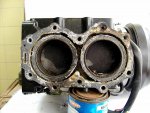I'm looking for someone who is very familiar with the 50HP Honda cooling passages for help on how to clean debris out. I've got a 1999 50HP Honda that suddenly developed an intermittent pee stream problem. The stream has good solid pressure, then suddenly the pressure drops very low and sometimes to a dribble. I've seen it happen while cruising, very solid stream then suddenly almost nothing. It's as if there is some debris inside the cooling system somewhere that suddenly blocks a passage way. It intermittently both in the water and on the flush muffs. If I turn the motor off and on again a few times, the stream will eventually return. It must still be getting good flow inside the motor because I've noticed the issue while cruising for extended periods of time at 5000rpm and it did not overheat, but this is our ocean boat so I really would like to get this resolved just in case. The blockage is not at the outlet for the pee stream as I've stuck a very thick and long weed whacker string up the tube while it is running to try to clear it out and that makes no difference at all. I've also replaced the water pump impeller (twice) and thermostat, but the problem persists. The wear plate and pump cup both look great, smooth and no grooves, and when it's working the pressure is excellent. All of the water passages in the lower unit are clear. Has anyone seen this before on a 50HP Honda?
Motor history; I bought this motor new in 1999 and it has been a year round saltwater motor since then. It gets flushed after every use and runs fantastic, so I would really like to get this fixed before it causes a real problem. I'm the only one to have serviced this motor and I've put numerous pumps in it over the years and no impeller has ever come out missing any pieces so I'm not sure what's in there.
Motor history; I bought this motor new in 1999 and it has been a year round saltwater motor since then. It gets flushed after every use and runs fantastic, so I would really like to get this fixed before it causes a real problem. I'm the only one to have serviced this motor and I've put numerous pumps in it over the years and no impeller has ever come out missing any pieces so I'm not sure what's in there.
Last edited:


























